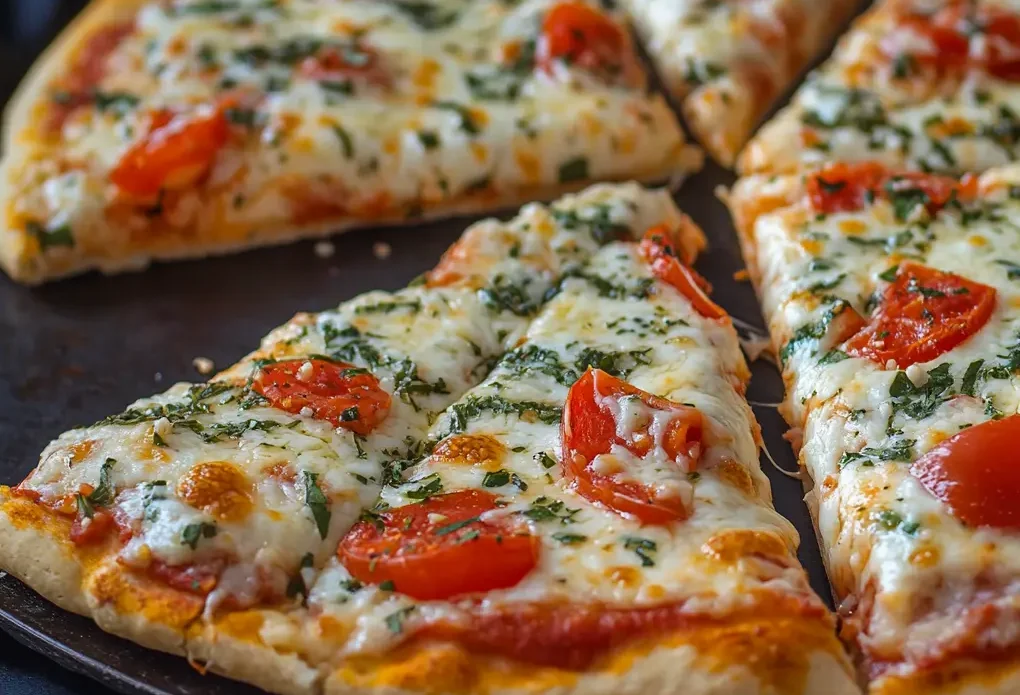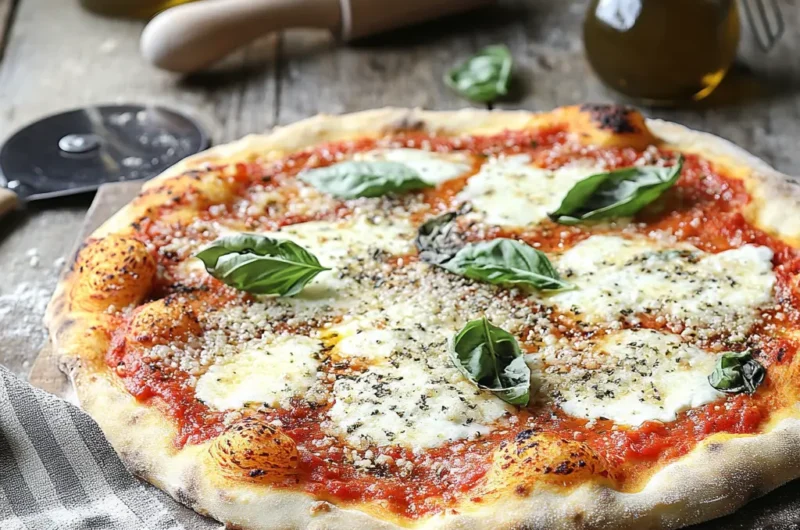Transform your pizza nights with the Cottage Cheese Pizza Crust, a culinary innovation that’s both health-conscious and indulgent. This creative twist on traditional pizza bases combines the creamy richness of cottage cheese with a light, crispy texture, delivering a crust that’s high in protein and packed with flavor.
Cottage Cheese Pizza Crust
Course: Main CourseCuisine: AmericanDifficulty: Easy4
servings10
minutes35
minutes200 kcal per serving
kcalIngredients
Core Ingredients
Cottage Cheese: 1 cup
Use full-fat for a richer, creamier crust or low-fat for a lighter option without sacrificing protein.
Eggs: 2 large
Acts as a binding agent, ensuring the crust holds together while staying fluffy.Flour Options
Almond Flour: ½ cup
Ideal for gluten-free recipes, almond flour adds a nutty flavor and light texture.
Substitution: Use all-purpose flour if gluten-free isn’t required for a more traditional crust.Flavor Boosters (Optional but Recommended)
Parmesan Cheese: ¼ cup, grated
Adds a savory, umami kick and enhances the crust’s golden-brown finish.
Garlic Powder: ½ teaspoon
Infuses subtle, aromatic flavor for a gourmet touch.
Italian Seasoning: 1 teaspoon
Blends herbs like oregano, basil, and thyme, giving the crust a classic pizza flavor.Leavening Agent
Baking Powder: 1 teaspoon
Provides a slight lift, ensuring the crust bakes evenly and doesn’t become dense.Seasoning Essentials
Salt: ½ teaspoon
Balances the flavors of the crust, enhancing its taste without overpowering.For Preparation
Olive Oil or Cooking SprayUse to g
rease parchment paper or a baking tray, preventing the crust from sticking while promoting a crisp exterior.Pro Tips for Ingredient Success
Blending Cottage Cheese: For a smoother texture, blend the cottage cheese in a food processor before mixing it with the other ingredients.
Customizable Add-Ins: Add a pinch of red chili flakes for heat or nutritional yeast for a cheesy, dairy-free boost.
Directions
- Step 1: Preheat the Oven
Preheat your oven to 400°F (200°C) for even cooking.
Line a baking sheet or pizza stone with parchment paper, and lightly grease it with olive oil or cooking spray to prevent sticking and promote a crispy crust. - Step 2: Blend the Wet Ingredients
In a large mixing bowl, combine cottage cheese and eggs.
Use a food processor or immersion blender to blend the mixture until it is smooth and free of lumps. This ensures a cohesive crust texture. - Step 3: Mix the Dry Ingredients
Add the following to the blended wet mixture:Almond flour
Parmesan cheese (optional, for extra flavor)
Baking powder
Garlic powder, Italian seasoning, and salt.
Stir until a thick, cohesive batter forms. - Step 4: Shape the Crust
Pour the batter onto the prepared parchment paper or pizza stone.
Use a spatula to spread the batter evenly, forming a 12-inch (30 cm) circle or your desired shape.
Aim for a crust thickness of about ¼-inch (0.6 cm) to ensure even baking. - Step 5: Bake the Crust
Transfer the crust to the preheated oven.
Bake for 20–25 minutes, or until the edges turn golden brown and the center feels firm to the touch. - Step 6: Cool the Crust
Remove the crust from the oven and let it cool for 5 minutes.Cooling prevents the crust from becoming soggy when you add toppings. - Step 7: Add Your Toppings
Spread your desired toppings evenly over the baked crust.Pro Tip: Avoid overly wet ingredients to maintain the crust’s crispness.
Topping Ideas:Classic Margherita: Tomato sauce, mozzarella, fresh basil.
Veggie Lover’s: Bell peppers, mushrooms, red onions, olives.
Protein-Packed: Grilled chicken, spinach, feta cheese.
Gourmet Style: Prosciutto, arugula, shaved Parmesan. - Step 8: Bake with Toppings
Return the pizza to the oven and bake for an additional 10–15 minutes, or until:The cheese is melted and bubbly.
Toppings are heated through. - Step 9: Serve and Enjoy
Let the pizza cool for 5 minutes before slicing. This resting time helps the crust hold together better.
Serve and enjoy your protein-packed pizza! - Extra Tips for Success
For Extra Crispiness: Flip the crust halfway through the first bake to achieve an even crunch.
Storage: Store leftover crust in the fridge for up to 3 days or freeze for up to 1 month.
Reheating: Use a preheated oven or toaster oven to restore crispness and freshness.
Table of contents
What is Cottage Cheese Pizza Crust?
Cottage cheese pizza crust is a health-conscious, protein-packed alternative to traditional pizza bases, offering the perfect balance of flavor, nutrition, and versatility. Made from cottage cheese, eggs, and gluten-free flours like almond or oat flour, this innovative crust is ideal for those looking to enjoy pizza without the carb-heavy drawbacks of refined wheat doughs. It’s a delicious option for anyone on a low-carb, keto, or gluten-free diet, or simply looking to try something new.
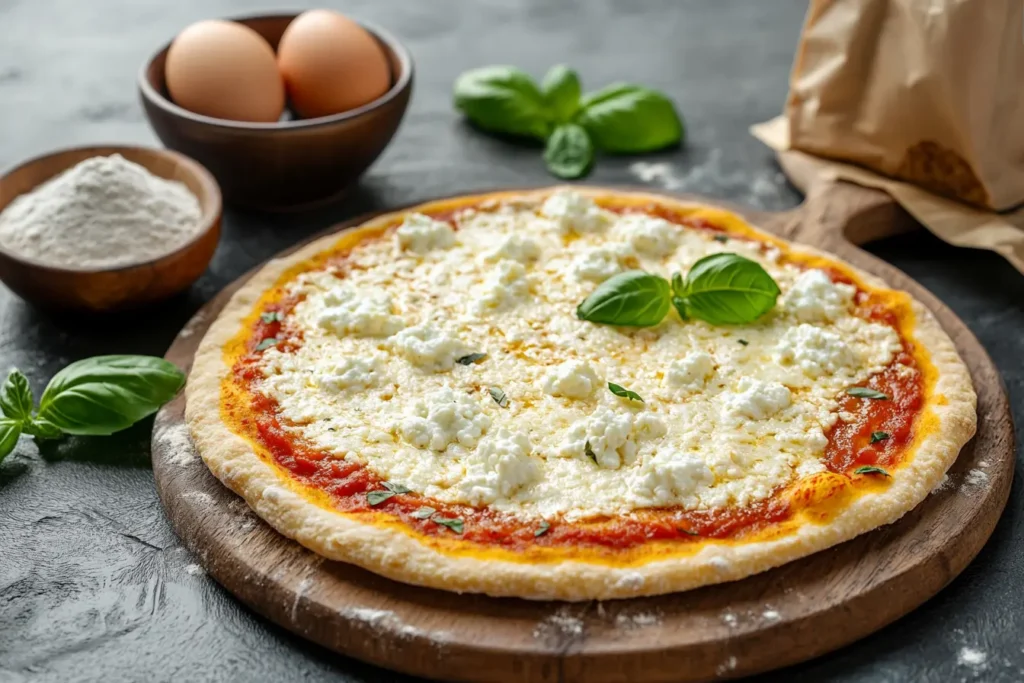
Why Choose Cottage Cheese Pizza Crust?
Cottage cheese pizza crust is not just a healthy alternative—it’s a nutritionally superior, versatile, and delicious option for anyone looking to enjoy pizza while staying aligned with health goals. Whether you’re managing weight, embracing a low-carb lifestyle, or exploring gluten-free options, this innovative crust checks all the boxes.
Key Ingredients of Cottage Cheese Pizza Crust
The simplicity of this crust lies in its wholesome, nutrient-rich ingredients:
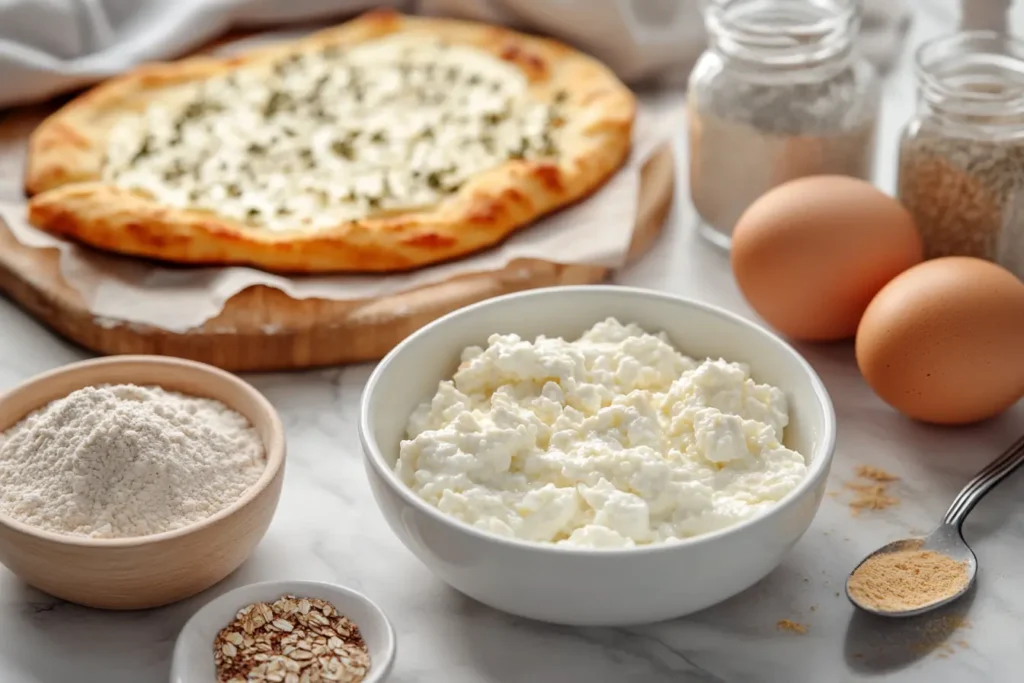
- Cottage Cheese:
- A star ingredient that adds creaminess and is rich in protein and calcium. Its high water content ensures a moist, tender crust while delivering a boost of essential nutrients.
- Eggs:
- Serve as the primary binding agent, holding the ingredients together for a cohesive, sturdy base.
- Almond or Oat Flour:
- Gluten-free options that add structure and maintain a light, crisp texture. Almond flour keeps the crust low in carbs, while oat flour provides a heartier feel for those not limiting carbohydrates.
- Seasonings (Optional):
- Enhance the flavor with garlic powder, Italian herbs, or a pinch of salt, creating a crust that complements a variety of toppings.
Comparison with Traditional Pizza Crusts
Cottage cheese pizza crust stands out as a nutrient-dense alternative to conventional pizza bases, which are typically made with refined wheat flour. Here’s how the two compare:
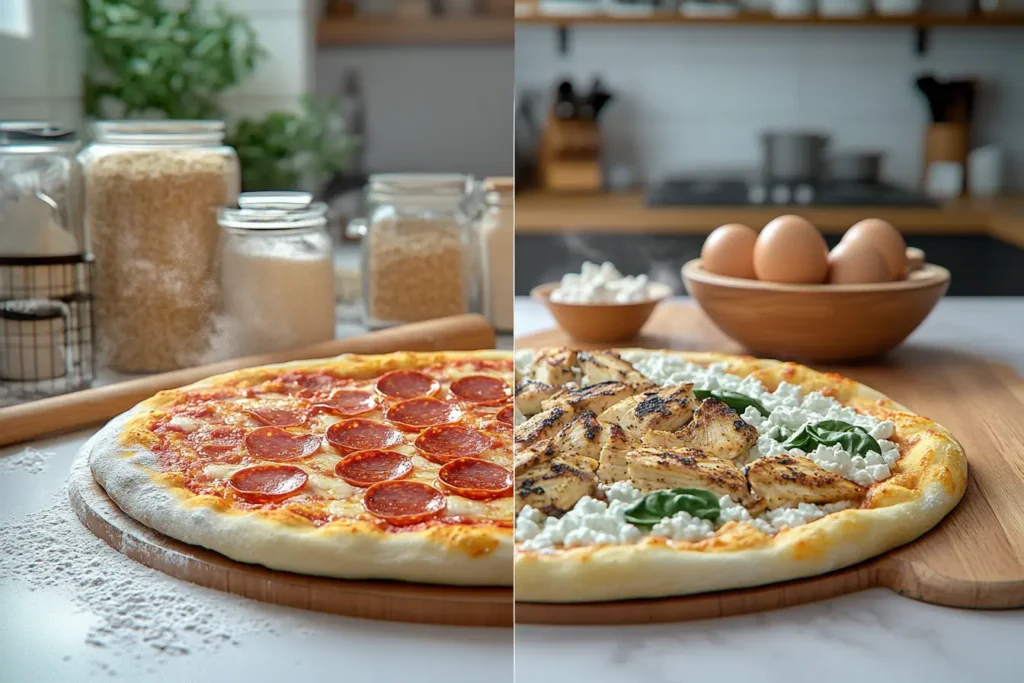
Traditional Pizza Crusts
- High in Carbohydrates: Can cause rapid blood sugar spikes, making them less ideal for individuals on low-carb or ketogenic diets.
- Low in Protein: Provides minimal satiety, often leading to overeating.
- Nutrient-Poor: Refined flours offer limited nutritional benefits and mostly empty calories.
Cottage Cheese Pizza Crust
- Reduced Carb Intake: Perfect for those looking to manage carbohydrate consumption without sacrificing taste.
- Protein Boost: With its high-protein content, it supports muscle repair, promotes satiety, and sustains energy levels.
- Nutrient-Dense: Loaded with vitamins, minerals, and healthy fats, it transforms pizza into a healthier meal option.
Looking for Bold Pizza Inspiration?
Explore innovative ideas and expert tips to take your pizza-making game to the next level. Whether you’re troubleshooting cheese adhesion or looking for creative topping ideas, these resources will help you craft the perfect pizza experience:
Cheese Not Sticking to Pizza? Here’s Why and How to Fix It: Struggling with cheese sliding off your pizza? This guide breaks down the common causes and provides actionable solutions for perfect cheese adhesion.
➡ Don’t miss out on these expert tips—an ideal complement to your cottage cheese pizza crust! Click here
Crab Brûlée Recipe: A Gourmet Delight for Special Occasions: Elevate your pizza with this luxurious topping idea! The sweet and savory flavors of Crab Brûlée pair beautifully with the protein-packed cottage cheese crust, making it a standout option for gourmet pizza nights.
➡ Don’t miss this Crab Brûlée recipe—it’s a creative topping idea that works wonderfully on your cottage cheese crust! Click here
Health Benefits of Cottage Cheese Pizza Crust
High Protein, Low Carb
Cottage cheese pizza crust is a protein powerhouse, making it perfect for:
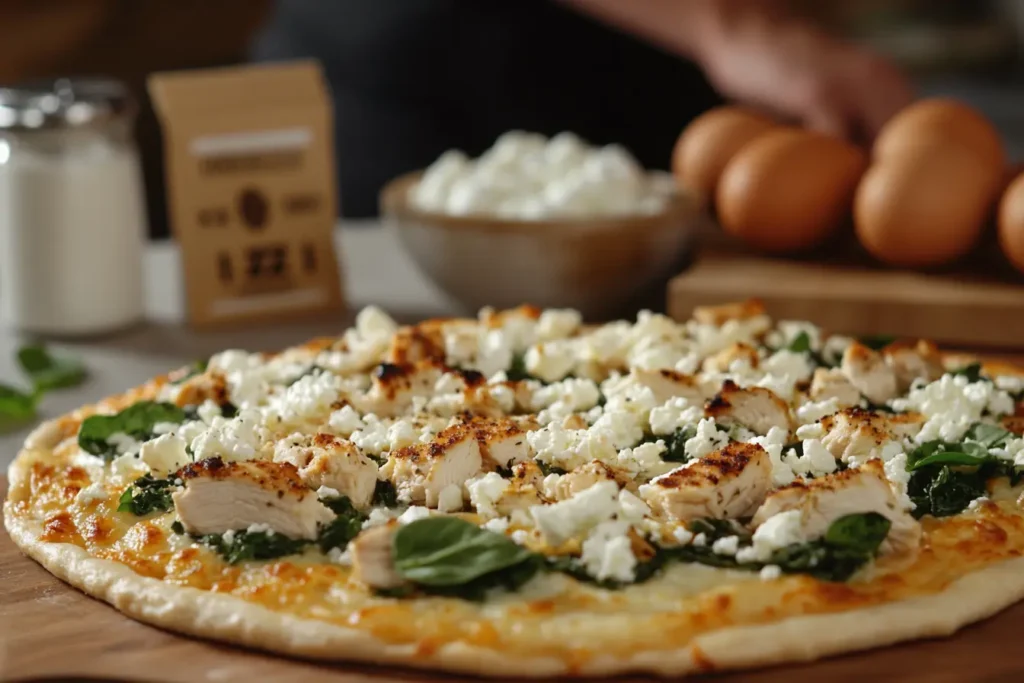
- Fueling the body: Essential for muscle recovery and sustained energy.
- Low-carb or ketogenic diets: Offers significantly fewer carbs compared to traditional crusts, keeping blood sugar levels stable.
- Improving satiety: High protein content keeps you full longer, reducing overeating.
📖 Source: Learn more about the benefits of high-protein diets from Harvard T.H. Chan School of Public Health.
Gluten-Free Option
For those with gluten intolerance or simply aiming to reduce gluten intake, cottage cheese pizza crust is a safe and satisfying choice:
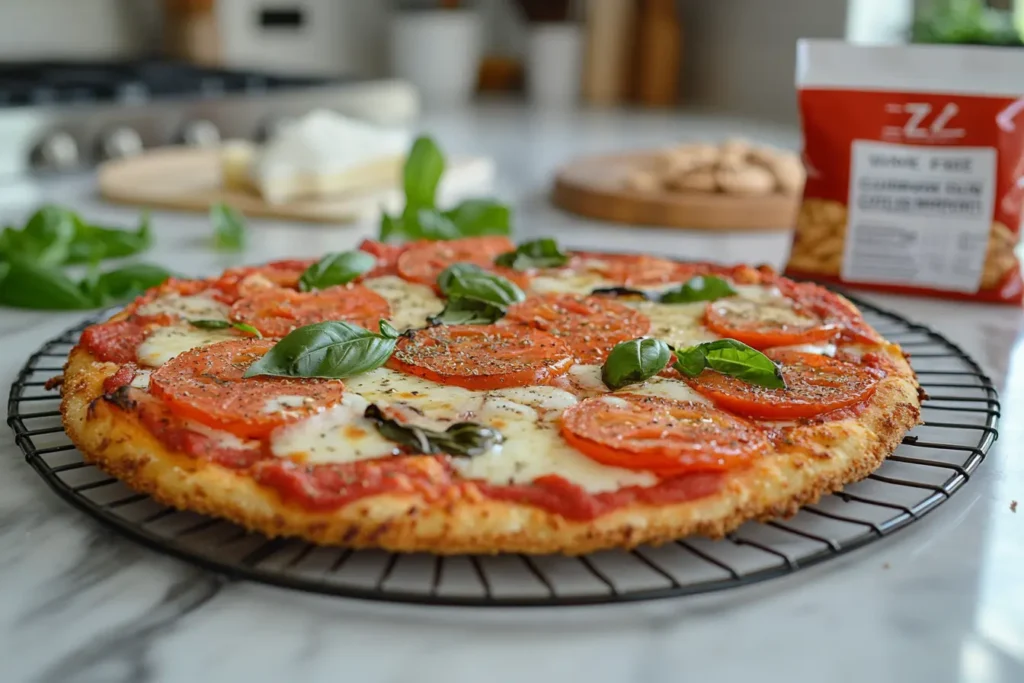
- Made with gluten-free flours like almond or oat flour, ensuring a texture and flavor that rivals traditional dough.
- Ideal for people managing celiac disease or gluten sensitivity.
📖 Source: Read more about gluten-free diets from Celiac Disease Foundation.
Great for Weight Management
This crust aligns perfectly with weight management goals:
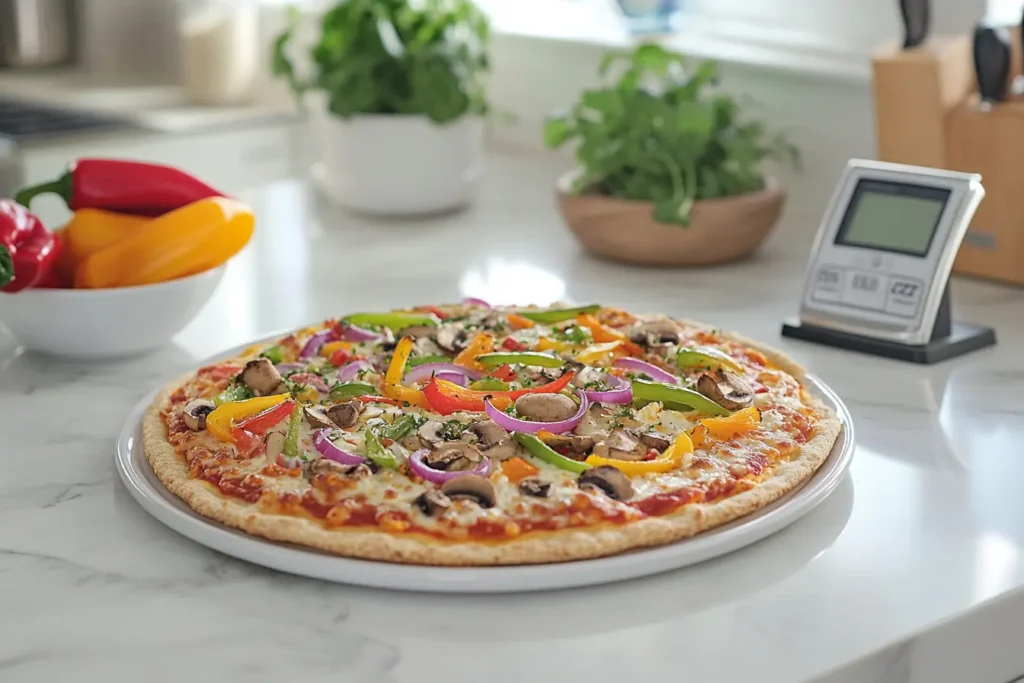
- Low in calories: Cottage cheese is naturally light yet nutrient-dense, offering essential vitamins like calcium and phosphorus.
- Supports hunger control: Its high protein content curbs hunger and helps maintain a balanced diet.
📖 Source: Learn how protein aids in weight management from Mayo Clinic.
Taste and Texture Advantages
Unlike alternative crusts that may be dry or bland, cottage cheese pizza crust offers:
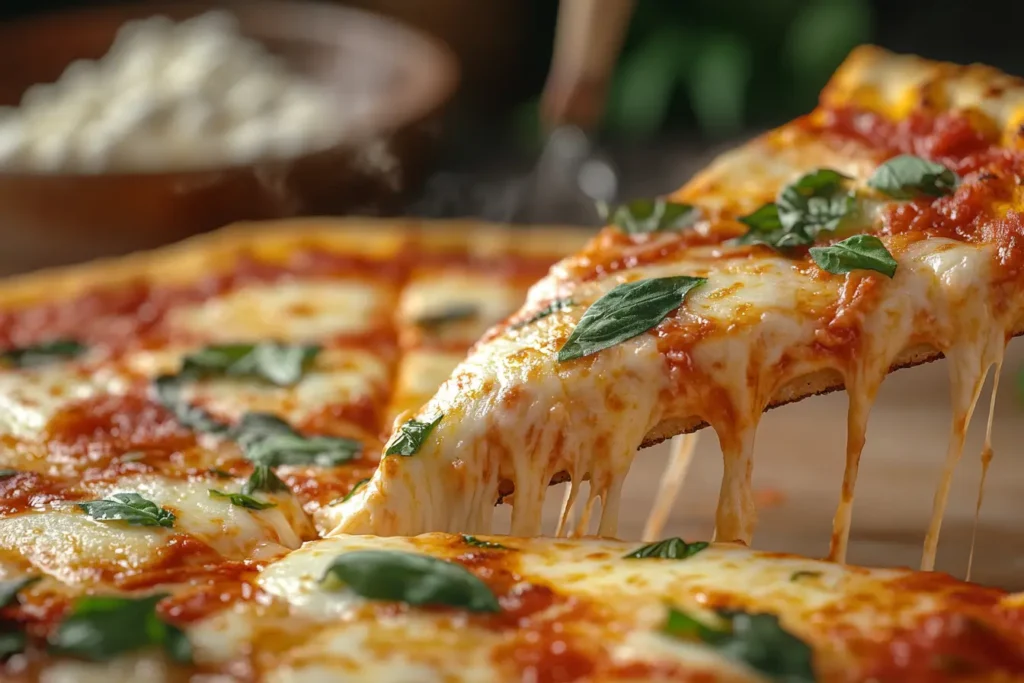
- Creaminess from cottage cheese: Adds a rich, subtle flavor that complements your toppings.
- Balanced texture: Eggs and flour provide a firm yet slightly chewy base, perfect for holding heavier toppings.
- Savory notes: Naturally enhances the overall taste of your pizza, eliminating the need for excessive seasoning.
Versatility in Recipes
The flexibility of this crust makes it a fantastic base for a wide range of dishes:
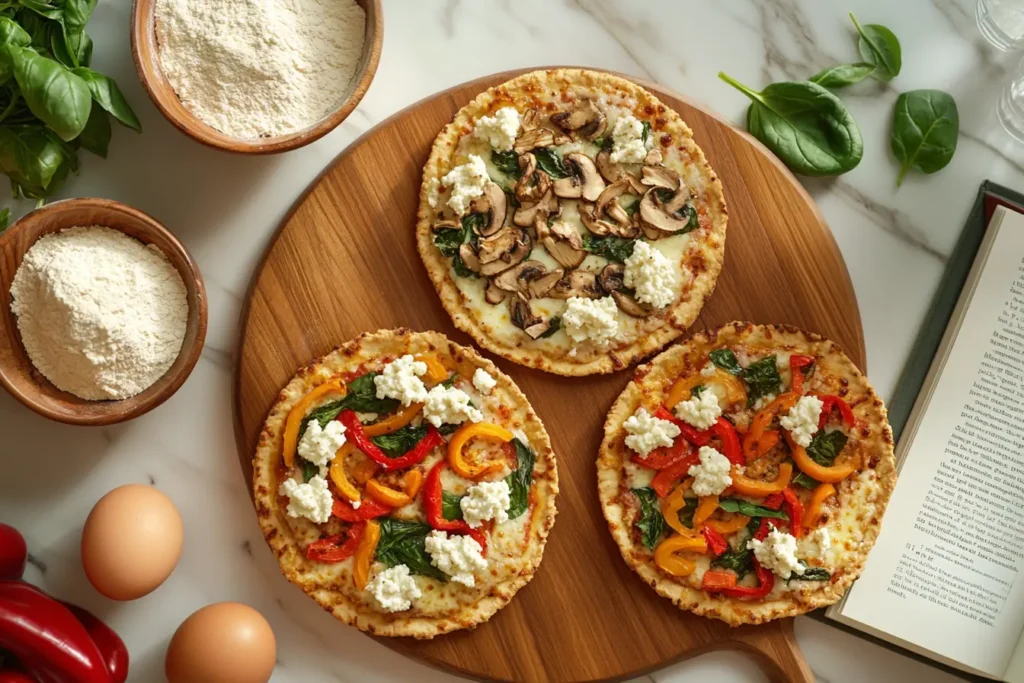
- Pizza Toppings: Works well with:
- Classic Margherita: Tomato, mozzarella, and basil.
- Protein-Packed: Grilled chicken, spinach, and feta.
- Veggie-Loaded: Bell peppers, mushrooms, and red onions.
- Other Dishes: Use it for flatbreads, mini-pizzas, or even savory tarts.
This multi-purpose crust allows you to get creative in the kitchen, offering endless possibilities for delicious and nutritious meals.
Cottage cheese pizza crust is the ultimate combination of health, taste, and versatility. It’s an excellent choice for:
- Health-conscious eaters seeking a low-carb, high-protein alternative.
- Gluten-free enthusiasts craving a safe and satisfying crust.
- Home cooks looking for a creative base to explore new recipes.
By choosing this crust, you’re not just making pizza—you’re creating a meal that supports your lifestyle and nourishes your body.
📖 Learn More:
- Explore the benefits of cottage cheese in more depth at Healthline.
Nutritional Benefits of Cottage Cheese
Cottage cheese is not only a tasty base but a powerhouse of nutrients:
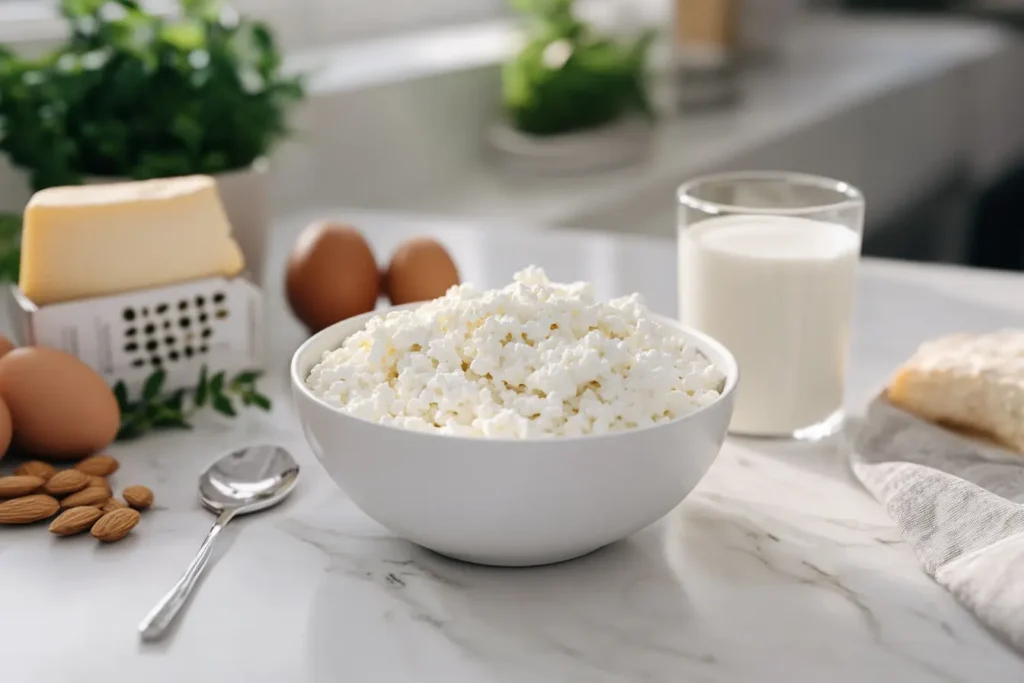
- High in Protein:
- Delivers approximately 28 grams of protein per cup, making it ideal for active individuals and those looking to build muscle or maintain satiety.
- Rich in Calcium:
- Supports bone health, muscle function, and nerve signaling.
- Low in Fat (Depending on Choice):
- Offers versatility with low-fat or full-fat options, catering to various dietary needs.
- Packed with Essential Nutrients:
- Contains phosphorus, B vitamins, and selenium, supporting overall health and energy metabolism.
Cottage Cheese Pizza Crust vs. Other Alternatives
When exploring healthier pizza crusts, several alternatives like cauliflower crust, almond flour crust, and zucchini-based crust compete for attention. However, cottage cheese pizza crust excels by combining ease of preparation, sturdy texture, and exceptional nutritional benefits. Here’s a detailed comparison:
Cauliflower Crust
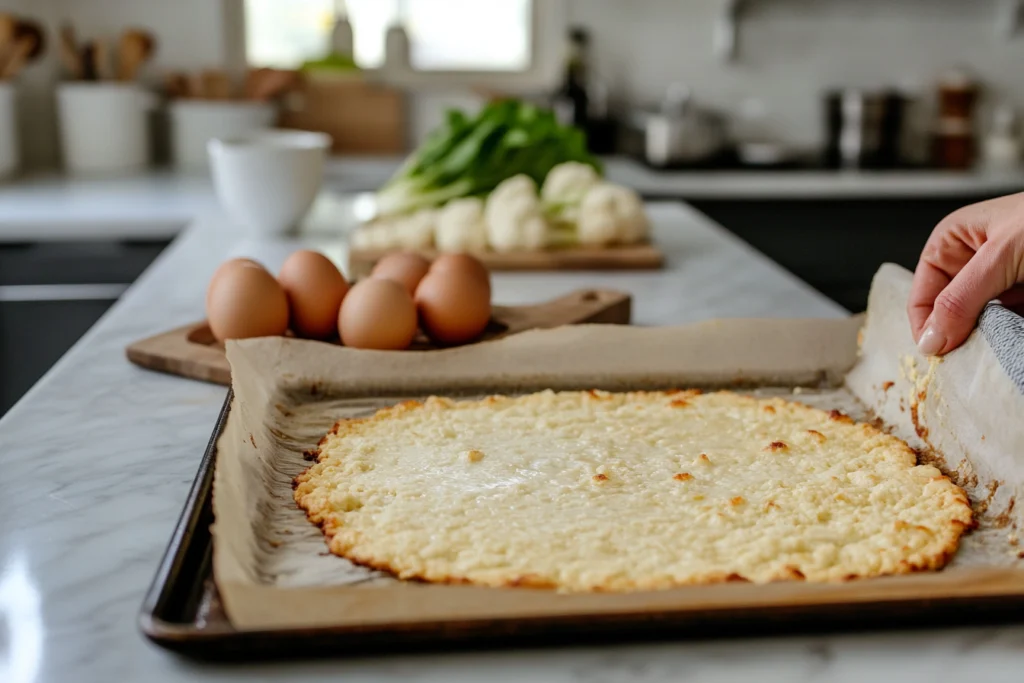
Pros:
- Low in carbs and calories: Perfect for keto and low-carb diets.
- Nutrient-dense: Packed with fiber, vitamin C, and antioxidants.
- Gluten-free: Ideal for individuals avoiding gluten.
Cons:
- Time-consuming: Requires steaming, squeezing excess water, and blending cauliflower into a workable dough.
- Fragile texture: Prone to crumbling, which can make it challenging to handle.
How Cottage Cheese Stands Out:
- Ease of preparation: Cottage cheese crust is simpler and faster to make with fewer steps.
- Protein boost: Offers significantly higher protein content than cauliflower crust, making it more satiating and ideal for high-protein diets.
- Sturdier texture: Holds toppings better, providing a more reliable pizza experience.
📖 Source: Learn more about the pros and cons of cauliflower crust at Healthline.
Almond Flour Crust
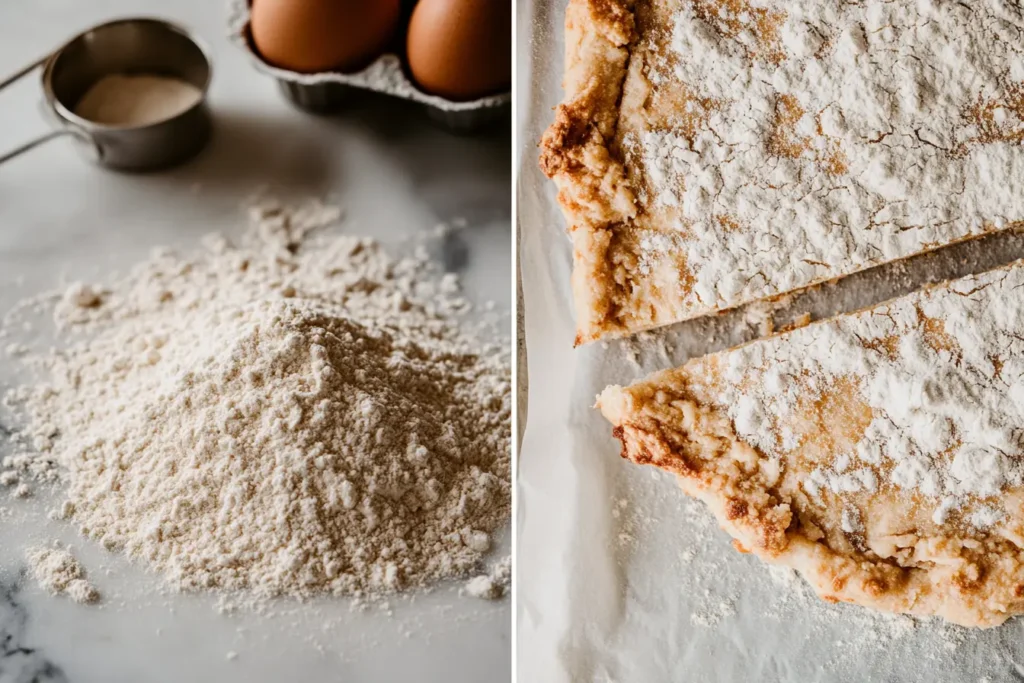
Pros:
- Gluten-free: Naturally free of gluten and suitable for celiac-friendly recipes.
- Rich in healthy fats: Supports heart health with monounsaturated fats.
- Easy to prepare: Requires minimal steps and no extensive preparation.
Cons:
- Calorie-dense: Higher in calories and fat, which may not suit individuals focusing on calorie control.
- Distinct nutty flavor: May not appeal to those seeking a traditional pizza taste.
How Cottage Cheese Stands Out:
- Lighter option: Cottage cheese crust is lower in calories and fat while still offering a satisfying, creamy flavor.
- Traditional texture: Mimics the chewiness of classic pizza dough better than the denser almond flour crust.
- Protein-rich: Delivers more protein, supporting muscle repair and satiety.
📖 Source: Explore the benefits and drawbacks of almond flour crust at Mayo Clinic.
Zucchini-Based Crust
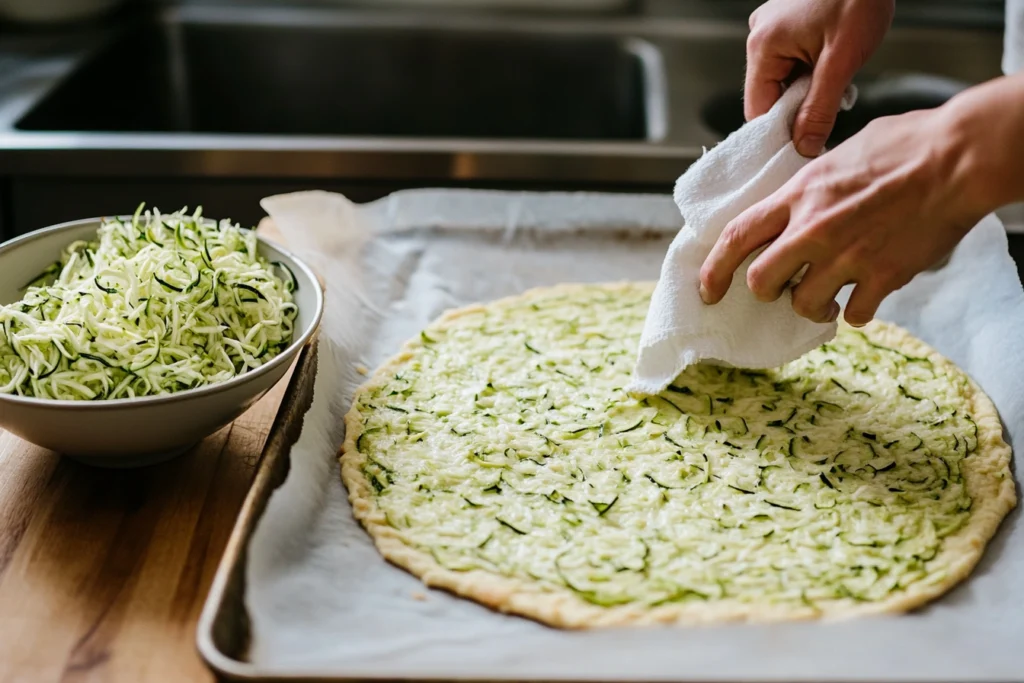
Pros:
- Low in carbs and calories: A great option for calorie-conscious eaters.
- Hydrating and nutrient-rich: Provides vitamins A and C, potassium, and antioxidants.
- Vegetable-forward: An easy way to incorporate more veggies into your meal.
Cons:
- Water content: Requires careful preparation (e.g., squeezing out moisture) to avoid sogginess.
- Crispness challenges: Achieving a firm texture can be tricky.
- Mild flavor: Lacks the robust taste of other crust alternatives.
How Cottage Cheese Stands Out:
- Firm texture: Cottage cheese crust holds its shape without requiring extensive moisture removal.
- Rich flavor profile: Adds a subtle creaminess and savory depth that zucchini crusts often lack.
- More filling: The high protein content makes it more satisfying and less reliant on bulky toppings.
📖 Source: Find tips for zucchini crust preparation at Celiac Disease Foundation.
Storage and Meal Prep Tips for Cottage Cheese Pizza Crust
Preparing your cottage cheese pizza crust ahead of time is a practical and healthy way to streamline mealtime. With proper storage, freezing, and reheating techniques, you can enjoy a fresh and flavorful pizza base whenever you need it. Here’s how to do it the right way:
Freezing the Crust
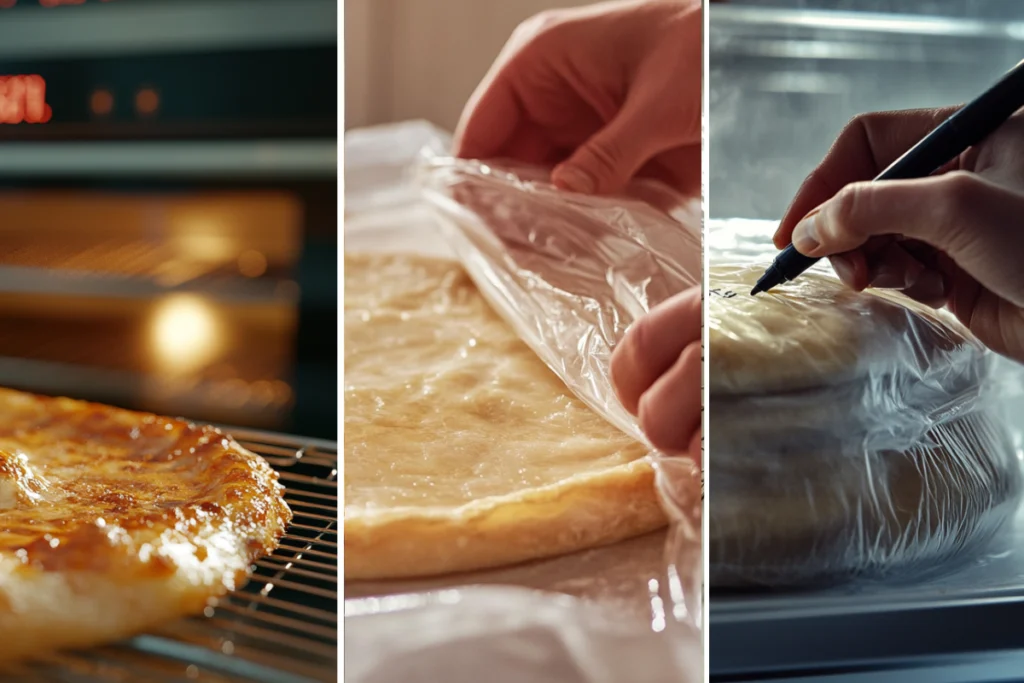
1. Bake First for Stability
- Always bake the crust before freezing to preserve its structure and texture. A fully baked crust ensures it won’t become soggy or fall apart during storage.
- Allow the crust to cool completely before proceeding to prevent condensation, which can lead to freezer burn.
2. Wrap and Protect
- Layer with Parchment Paper: Place the cooled crust on a sheet of parchment paper.
- Wrap Tightly: Use plastic wrap or aluminum foil to tightly seal the crust, ensuring no air exposure.
- Double Bag for Extra Protection: Store the wrapped crust in a resealable freezer bag to keep it safe from freezer burn and odors.
3. Label and Freeze
- Write the date on the bag for easy tracking.
- Store in the freezer for up to 3 months for optimal freshness.
📖 Source: Learn more about freezing baked goods at FoodSafety.gov.
Reheating the Crust
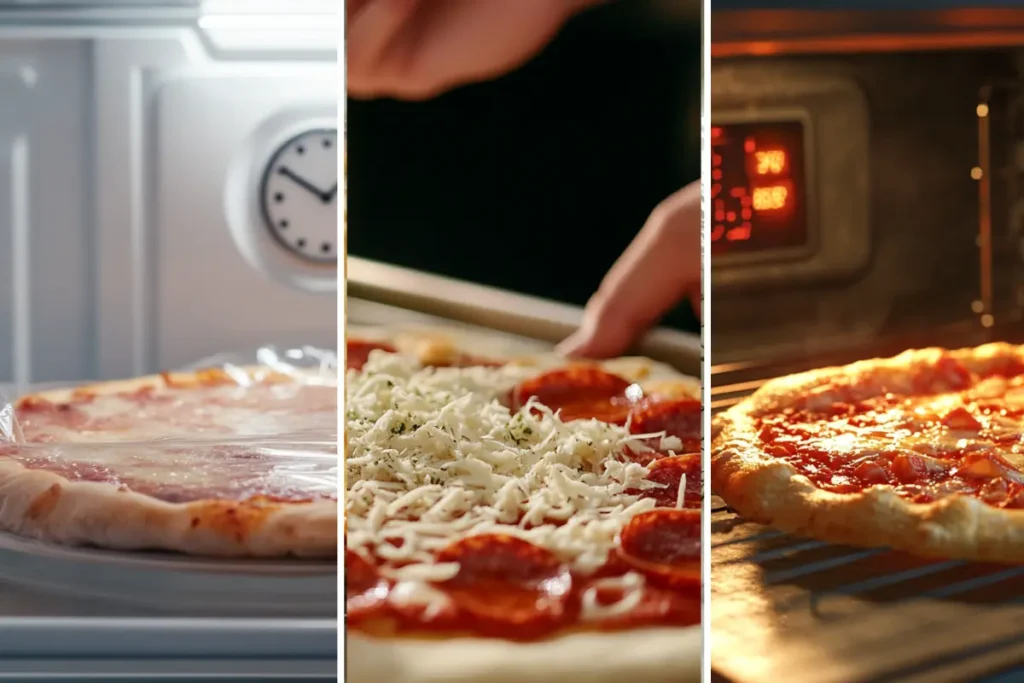
1. Thaw Overnight
- Transfer the frozen crust to the refrigerator and thaw overnight for even defrosting without compromising texture.
2. Reheat the Crust
- Preheat your oven to 375°F (190°C).
- Place the crust on a baking sheet and warm for 5–7 minutes or until it regains its crispness.
- Reheating before adding toppings ensures the crust stays firm and supports your ingredients.
3. Add Toppings and Finish Baking
- Once reheated, layer the crust with your favorite toppings.
- Bake at 375°F (190°C) until the toppings are heated through, and any cheese is melted and bubbly (typically 10–15 minutes).
📖 Source: Explore pizza reheating tips at Serious Eats.
Making the Crust Ahead of Time
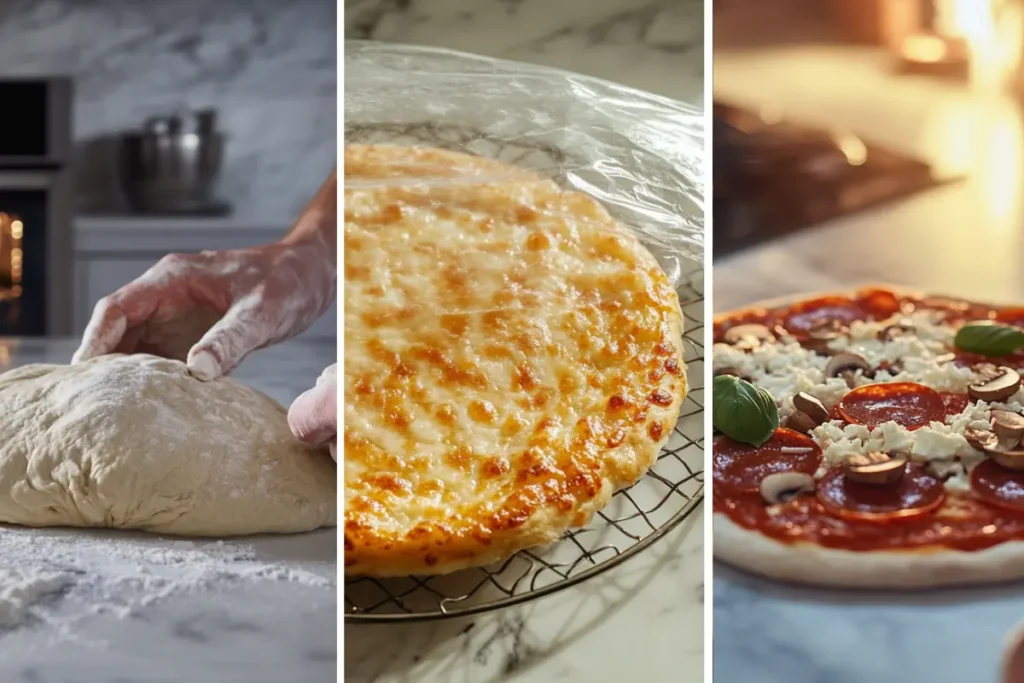
1. Prep and Bake in Advance
- Follow the recipe to prepare and bake the crust as directed.
2. Refrigerate for Short-Term Use
- Store the fully baked crust in an airtight container or wrap tightly in plastic wrap.
- Keep in the refrigerator for up to 5 days for quick, easy meals during the week.
3. Add Toppings and Bake
- When ready to serve, add your desired toppings directly to the crust and bake as usual.
Pro Tips for Meal Prep Success
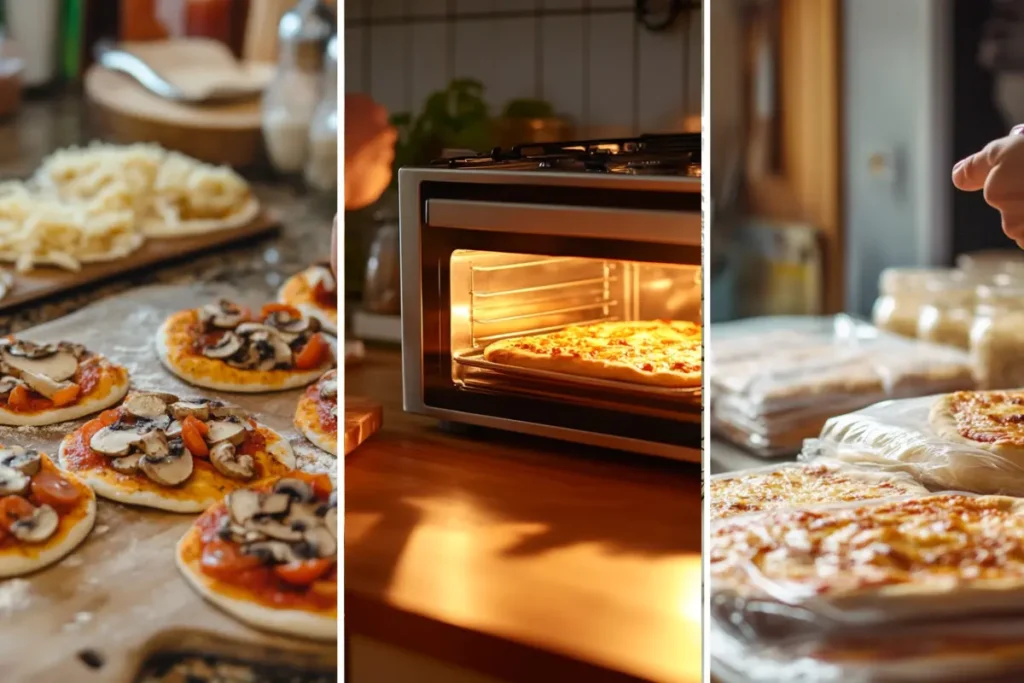
- Batch Baking: Bake multiple crusts at once to save time and energy. Freeze or refrigerate extras for later use.
- Portion Control: Make mini or personal-sized crusts for portion-controlled meals or kid-friendly options.
- Quick Reheat Options: Use a toaster oven or air fryer for faster reheating while preserving crispness.
Why This Matters
By incorporating these storage and meal prep tips, you can ensure that your cottage cheese pizza crust remains fresh, flavorful, and convenient for any meal. Whether you’re planning a weeknight dinner or hosting a last-minute pizza party, having a prepped crust ready to go saves time and effort without compromising on quality.
📖 More Resources:
- Learn about meal prep best practices at Healthline.
- Explore freezing techniques for healthier cooking at USDA Freezing and Food Safety.
FAQs About Cottage Cheese Pizza Crust
Cottage cheese pizza crust is a versatile, nutritious option gaining popularity among health-conscious food enthusiasts. Here, we answer some frequently asked questions to help you make the most of this innovative recipe.
Can I Use Low-Fat Cottage Cheese?
Yes, you can use low-fat cottage cheese to prepare the crust. This variation works just as well and offers a lighter calorie count, making it ideal for those monitoring their fat intake. While low-fat versions might have a slightly milder flavor, the difference is minimal, and the texture remains consistent.
Is Cottage Cheese Pizza Crust Suitable for Keto?
Absolutely! Cottage cheese pizza crust is a fantastic choice for keto diets. It’s low in carbs and packed with protein, fitting perfectly within the macronutrient requirements of ketogenic meal plans. To keep the entire pizza keto-friendly, use low-carb toppings such as cheese, spinach, mushrooms, and grilled chicken.
How Does It Compare to Other Gluten-Free Crusts?
Cottage cheese pizza crust stands out among gluten-free options for its high protein content and ease of preparation. Unlike cauliflower or zucchini-based crusts, which can be fragile and labor-intensive, cottage cheese crust is sturdy and simple to make. It also offers a creamier, richer flavor compared to almond flour crusts, which are denser and higher in calories.
Can I Make It Dairy-Free?
While the primary ingredient in this crust is dairy-based, you can adapt it for a dairy-free version. Substitute cottage cheese with a high-protein, dairy-free alternative, such as tofu or plant-based ricotta. Use nutritional yeast to add a cheesy flavor, and ensure any other ingredients used are dairy-free. The result may vary slightly in texture and taste but will still be a delicious alternative.
What Toppings Work Best?
Cottage cheese pizza crust is versatile and pairs well with a variety of toppings, including:
Classic Choices: Margherita with tomato, mozzarella, and basil; or turkey pepperoni with marinara sauce.
Gourmet Options: Smoked salmon and arugula, goat cheese and figs, or mushroom medley with truffle oil.
Vegetarian Ideas: Roasted vegetables, Mediterranean-inspired toppings like olives and sun-dried tomatoes, or pesto with fresh spinach.
Plant-Based Alternatives: Use vegan cheese, sautéed veggies, and dairy-free pesto for a wholesome, vegan-friendly pizza.
Conclusion: Why Cottage Cheese Pizza Crust is a Must-Try
Cottage cheese pizza crust is a game-changing alternative for pizza lovers seeking to balance indulgence and nutrition. Whether you’re exploring gluten-free options, cutting carbs, or boosting your protein intake, this crust offers the perfect combination of taste, texture, and versatility to fit any lifestyle.
By combining wholesome ingredients like cottage cheese, eggs, and almond or oat flour, this innovative crust delivers a creamy, firm base that’s easy to prepare and endlessly customizable. It’s a nutritious foundation that supports diverse diets, from low-carb to high-protein, while still delivering on flavor.
Why You’ll Love It
- Nutrient-Dense: Packed with protein, calcium, and essential vitamins for energy and satiety.
- Versatile: Perfect for all your favorite toppings or as a base for other recipes like flatbreads or tarts.
- Convenient: Easy to make ahead, store, and reheat for quick, healthy meals anytime.
Make It Your Own
Pair this crust with your favorite toppings—classic margherita, veggie-loaded, or protein-packed creations—to create a pizza experience that’s as delicious as it is nourishing.
Cottage cheese pizza crust is more than just a healthier alternative—it’s a culinary upgrade that brings creativity, flavor, and nutrition to the table. Whether you’re a foodie, health enthusiast, or simply someone who loves pizza, this crust is worth adding to your recipe repertoire.
Let me know if you Ready to try it

